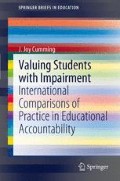Abstract
This book analyses legislation, policy and enacted practices in the US, England and Australia to examine the inclusion of students with disability in educational accountability assessments. While practices in the US, England and Australia do not generalize to practices worldwide, these countries are well-placed economically and politically to pursue best educational practice for students with impairment and well-advanced in both educational provision and educational accountability systems. Chapter 1 analyses the two policy imperatives that form the juncture for the discussion in this book. It provides an overview of the human rights-based policy imperatives for inclusive education of students with disability that inform education in the US, England and Australia. It also examines the educational accountability policies in place for all students in the US, England and Australia and the rationales underpinning these policies. Following brief discussion of two models of disability, the social model and the medical model, Chap. 1 presents the eight core assumptions in educational accountability with students with disability elaborated in Chap. 4, argued on the basis of discussion presented in Chaps. 2 and 3.
Access this chapter
Tax calculation will be finalised at checkout
Purchases are for personal use only
Notes
- 1.
It is often queried as to whether England as part of Great Britain or the United Kingdom is a country, nation or nation-state. In this book, the term country is used. It should be noted that educational policy and practice differ across England, Scotland, Wales and Northern Ireland.
- 2.
Respective signatory dates are 30 July 2009 for the US and 30 March 2007 for England and Australia.
- 3.
Ratification dates were 23 December 2010 for the European Union, 17 July 2008 for Australia.
- 4.
- 5.
The UN (2010, p. 18) states: “In Malawi and the United Republic of Tanzania, being disabled doubles the probability that a child will never attend school, and in Burkina Faso the risk rises to two and a half times. Even in some countries that are closer to achieving the goal of universal primary education, children with disabilities represent the majority of those who are excluded. In Bulgaria and Romania, net enrolment ratios for children aged 7–15 were over 90% in 2002, but only 58% for children with disabilities.”
- 6.
Potts (1998) considers social and cultural contexts of education for students with disability in Hong Kong and the argument that it is a Western and privileged “luxury.” However, an integrated education policy was adopted in Hong Kong in 2007 to provide for students with all but the most serious special educational needs to receive education in ordinary schools (Education Bureau 2007).
- 7.
This stated gain by OECD is in the context of the test outcomes for a testing program run by OECD itself, so may not generalize to school outcomes for all students. The gain was an average of 3.5 points higher on a science test scale with a mean set at 500 points. As noted later, OECD comparative test programs do not include students with disability. However, this and similar statements by the OECD have directly driven educational accountability agendas in many countries.
- 8.
Impairment is introduced as the preferred terminology during discussion of Assumption 3 and used thenceforth in the book and its title.
References
Anderson, J. A. (2005). Accountability in education. Brussels and Paris: International Academy of Education (IAE) and International Institute for Education Planning (IIEP) (UNESCO).
Breen, L., Green, M., Orarty, L., & Sagers, S. (2008). Towards embedding wellness approaches to health and disability. Journal of Allied Health, 37(3), 173–179.
Chen, Y. Y. (1996). Making special education compulsory and inclusive in China. Cambridge Journal of Education 26(1), 47–58.
Disability Discrimination Act (DDA) [Aus], Cth (1992).
Education Bureau, Government of the Hong Kong Special Administrative Region (2007). Whole school approach to integrated education. Retrieved September 30, 2011 from http://www.edb.gov.hk/index.aspx?nodeid=6559&langno=1.
Equality Act (UK) (2010).
Individuals with Disabilities Education Act (IDEA) [US], Pub. L., No. 108–446, § 104 Stat. 1142 (2004).
Johnson, J., & McIntosh, A. (2009). Towards a cultural perspective and understanding of the disability and deaf experience in special multicultural education. Remedial and Special Education, 30, 67–83.
Norwich, B. (2010). Dilemmas of difference, inclusion and disability: international perspectives on placement. European Journal of Special Needs Education, 23(4), 287–304.
Organisation for Economic Co-Operation, Development (OECD). (2004). What makes school systems perform, seeing school systems through the prism of PISA. Paris: OECD.
Organisation for Economic Co-Operation, Development (OECD). (2008). Education at a glance 2008. Paris: OECD.
Potts, P. (1998). A luxury for the first world: a western perception of Hong Kong Chinese attitudes towards inclusive education. Disability and Society, 13(1), 113–124.
Rustemier, S. (2002). Inclusive education—A worldwide phenomenon. Retrieved August 24, 2011 from http://inclusion.uwe.ac.uk/inclusionweek/articles/worldwide.htm.
Rutkow, L., & Lozman, J. T. (2006). Suffer the children?: a call for United States ratification of the United Nations convention on the rights of the child. Harvard Human Rights Journal, 19, 161–190.
Sharma, U., & Deppeler, J. (2005). Integrated education in India: Challenges and prospects. Disability Studies, 25(1). Retrieved September 30, 2011 from http://www.dsq-sds.org/article/view/524/701.
Swain, J., French, S., & Cameron, C. (2003). Controversial issues in a disabling society. Buckingham: Open University.
United Nations (UN). (2007). Convention on the rights of persons with disabilities (opened for signature 30 March 2007). New York: United Nations.
United Nations (UN). (2010). The millenium development goals report 2010. New York: United Nations.
Author information
Authors and Affiliations
Corresponding author
Rights and permissions
Copyright information
© 2012 The Author(s)
About this chapter
Cite this chapter
Cumming, J.J. (2012). Toward Equitable Provision of Education for Students with Disability in Education. In: Valuing Students with Impairment. SpringerBriefs in Education. Springer, Dordrecht. https://doi.org/10.1007/978-94-007-2935-3_1
Download citation
DOI: https://doi.org/10.1007/978-94-007-2935-3_1
Published:
Publisher Name: Springer, Dordrecht
Print ISBN: 978-94-007-2934-6
Online ISBN: 978-94-007-2935-3
eBook Packages: Humanities, Social Sciences and LawEducation (R0)

